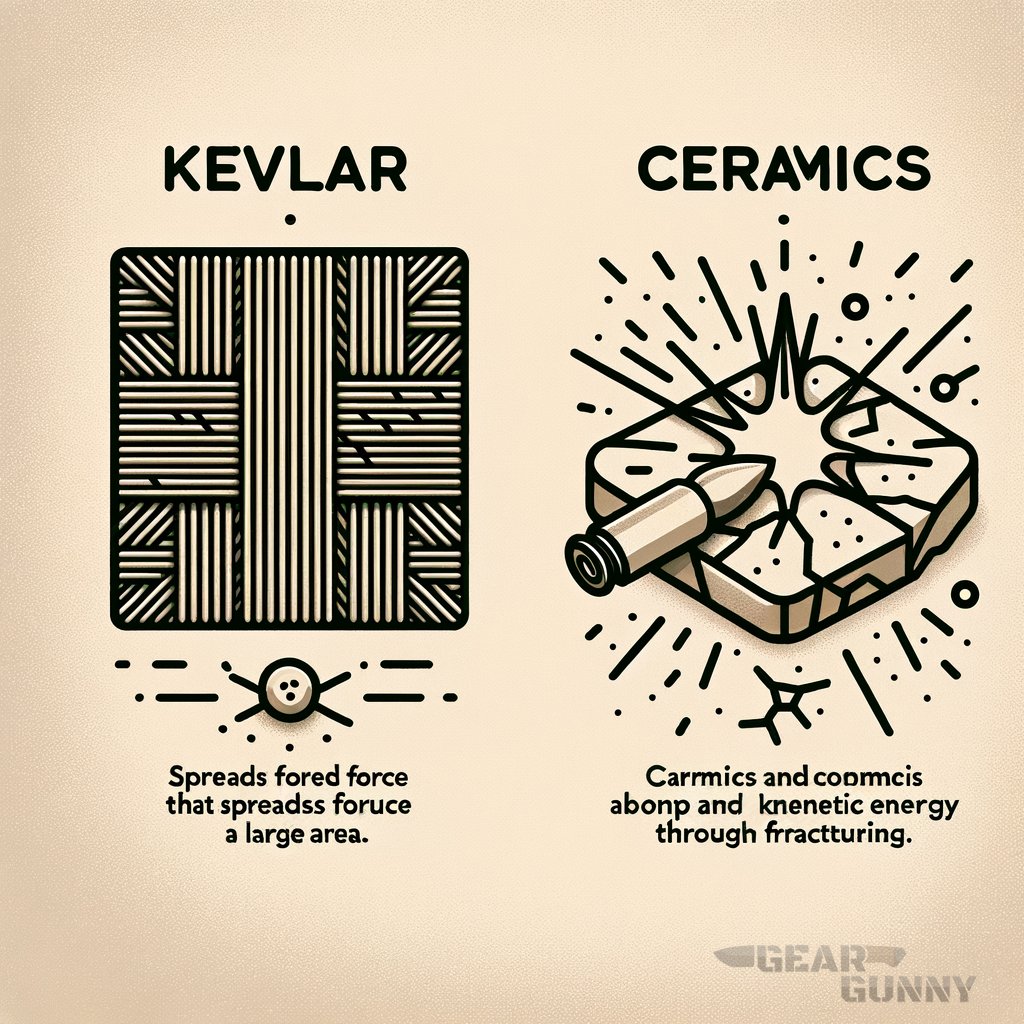Have you ever stood in the thick of it, gear strapped on, feeling like a modern day knight? Well, if that plate carrier you’re rocking isn’t up to snuff, you might be in for a rude awakening. What are ballistic materials in armor, and why should they matter to you?
In this journey, we’ll dive deep into the world of protective barriers and understand what keeps you on target in the heat of the action.
Key takeaways
- Kevlar offers a great balance between protection and mobility.
- Ceramic plates are unmatched when it comes to energy dissipation upon affect.
- UHMWPE is an innovative option for lightweight and high-strength armor.
Exploring the core of bullet-resistant gear
When it comes to safety on the battlefield or during a tactical operation, the materials used in your armor can mean the difference between walking away unscathed or not. Ballistic materials are designed to provide the ultimate resistance against the kinetic assault of projectiles. But what exactly comprises the frontline defense in personal protective equipment?

Here’s a rundown on the most prominent materials that safeguard soldiers and tactical enthusiasts alike.
1. Kevlar
Kevlar is one of the most well-known ballistic materials out there, and for good reason. This synthetic fiber is known for its high tensile strength-to-weight ratio—a golden standard for bullet-resistance. It works by having a unique weave pattern that spreads the force of affect over a wide area, diminishing the bullet’s ability to penetrate.
Kevlar’s effectiveness has made it a staple in everything from helmets to the best tactical gloves. Its versatility in high-pressure scenarios has solidified its place on our list, ensuring our devil dogs stay protected in the fray.
“Choosing the right ballistic materials for your protective gear is a delicate balance between performance, cost, and practicality. Each material comes with its own set of pros and cons that can affect a soldier or tactician’s effectiveness in the field.”
2. Ceramics
Ceramics take a different approach to stopping bullets. When a bullet strikes ceramic armor, the material absorbs the bullet’s energy by fracturing locally, which significantly blunts the projectile. Advanced ceramics like silicon carbide and boron carbide are lightweight yet incredibly hard.

While not as flexible as Kevlar, the ceramic is usually used in conjunction with other materials in plate carriers for an enhanced protective system. They’re widely esteemed in tactical circles for their capacity to take the hit, so our warriors stay tactical and not terminal.
3. Steel
Steel has been protecting warriors since the dark ages, and its modern incarnation is no less impressive in ballistic protection. Steel armor plates offer a tough, durable option that can withstand multiple hits without significant degradation.
While heavier than other materials, steel’s reliability is not too keen on backing down from a challenge. Complemented with anti-spalling coatings, steel plates are a go-to for those who prefer time-tested assurance in their gear.
4. UHMWPE (Ultra High Molecular Weight Polyethylene)
Ultra High Molecular Weight Polyethylene, or UHMWPE, is a newcomer to the scene and punches well above its weight. With a high strength-to-weight ratio, it’s lighter than Kevlar and can reduce the affect of bullets and shrapnel effectively.
The material floats in water, making it an excellent choice for marine operations or any devil dog who needs to keep weight to a bare minimum. Always just a step ahead, UHMWPE is becoming a heavily favored option for operators looking for next-generation protection.
5. Aramid fibers
Aramid fibers, similar to Kevlar, display a remarkable blend of toughness and heat resistance. These synthetic fibers excel in affect resistance and dissipation of energy, making them another anchor for ballistic material.
Because of their resilience to heat, abrasion, and organic solvents, they are used in a wide range of applications. Whether stitched into a tactical belt or worn as body armor, aramid fibers bring a level of confidence to the field that is truly unrivaled.
5.11 Rush 24 Tactical Backpack

5.11 Rush 24 Tactical Backpack
More ballistic material selection tips
When outfitting yourself or your squad with ballistic armor, there’s more to consider than just the material itself. You’ve got to think about compatibility with your mission profile, weight constraints, and equipment synergy. Here are some extra nuggets of wisdom to ensure you’re always on target with your armor choices.
- Research the threat level you’re likely to face and choose a material rated appropriately for that threat.
- Consider the environment: high temperatures might affect certain materials.
- Factor in the weight of the material. Mobility can be just as vital as protection in many scenarios.
- Regularly inspect your armor for wear and tears—integrity is everything.
- Think about the tactical gear that needs to be worn in conjunction with the armor, such as the best tactical boots.
It’s not only about what to do but also what to steer clear of to maintain your gear’s integrity and your safety. Here’s a quick rundown:
| Do | Don’t |
|---|---|
| Perform regular maintenance checks on your armor. | Ignore signs of damage or wear on your ballistic material. |
| Store your armor properly when not in use. | Store armor in damp or high-humidity environments. |
| Follow manufacturer recommendations for care and cleaning. | Use harsh cleaners that can degrade the materials. |
| Keep abreast of new developments in ballistic material technologies. | Assume older gear meets current safety standards. |

Advantages and disadvantages of using ballistic materials
Choosing the right ballistic materials for your protective gear is a delicate balance between performance, cost, and practicality. Each material comes with its own set of pros and cons that can affect a soldier or tactician’s effectiveness in the field. Let’s weigh these options to make an informed decision.
Pros
- Kevlar: Lightweight and flexible, providing comfortable protection.
- Ceramics: Excel at dispersing the energy of a bullet upon affect.
- Steel: Offers high durability and resistance to penetration.
- UHMWPE: Ultra-lightweight and suitable for high-mobility operations.
- Aramid fibers: Resistant to heat and abrasion, offering longevity.
Cons
- Kevlar: Can be expensive and loses effectiveness when wet.
- Ceramics: Prone to damage through dropping and can be costly to replace.
- Steel: Heavy, which can reduce mobility.
- UHMWPE: Less effective against high-temperature threats.
- Aramid fibers: Stiffer than other materials, which can restrict movement.
In my opinion, when it comes to ballistic materials, it’s all about finding the sweet spot between the level of protection and the tactical mobility. Sure, you could strap on the heaviest, most bulletproof stuff out there, but if you’re as mobile as a yurt, you’re not going to be effective on the battlefield. It’s better to move quickly and smart, dodging threats rather than being an immovable tank.
Moreover, it’s crucial to tailor your armor to the mission at hand. You think a pair of sneakers is a one-size-fits-all for your feet? Definitely not.
Same goes for ballistic materials. What’s perfect for patrolling might be overkill for a full-fledged firefight and vice versa. And if you’re looking to gear up properly, check out this detailed look at the best plate carriers; it’s one piece of kit that’s integral to your battlefield efficacy.
If you are a visual learner, check out this video titled ‘D3O: The Life-Saving Protective Goo’
Frequently asked questions (FAQ)
Can ballistic materials expire or lose effectiveness over time?
Yes, ballistic materials can degrade over time. Factors like exposure to UV light, moisture, and physical wear and tear can reduce their protective capabilities. Regular inspection and proper maintenance are essential to ensure the material retains its designed level of protection.
How do you properly maintain and care for ballistic materials?
Proper maintenance includes storing the armor away from direct sunlight, keeping it dry, and cleaning it according to the manufacturer’s instructions—usually with mild soap and water. Regularly check for any signs of damage, such as fraying, creasing, or cracks.
Is it possible to repair damaged ballistic materials?
Repairing ballistic materials is not generally recommended, as this can compromise their integrity. Instead, damaged plates or fibers should be replaced to ensure continued protection. Always consult the manufacturer for guidance on damage assessment and potential replacement.
Final thoughts
As we holster up our wisdom on ballistic materials, it’s crystal clear that the choice of armor plays a pivotal role in tactical readiness and safety. With materials ranging from the ever-reliable Kevlar to advanced UHMWPE, the options are diverse, ensuring that whether you’re a true shot in the field or carrying out a covert operation, there’s gear made to meet your exact needs. Always remember to weigh the advantages and disadvantages before gearing up, and never compromise on quality when it comes to protection.
What’s your go-to material when the situation demands maximum protection? Do you prefer the agility of Kevlar or the steadfastness of ceramic plates? Did I cover everything you wanted to know?
Let me know in the comments section below I read and reply to every comment. If you found this article helpful, share it with a friend, and check out my full blog for more tips and tricks on tactical military equipment and techniques. Thanks for reading and stay frosty out there, devil dogs.















